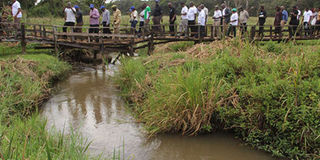Need to conserve key wetlands in Kenya

Saiwa Swamp National Park in Trans Nzoia County. Kenya needs to manage and conserve its wetlands. PHOTO | FILE | NATION MEDIA GROUP
What you need to know:
- As unique ecosystems, wetlands are highly valued for the services and functions they provide to human beings and other animals and plants.
- They also mitigate climate change and are habitats and centres of key biodiversity and socio-economic importance.
Tomorrow is the World Wetlands Day, which marks the adoption of the Convention of Wetlands (Ramsar Convention) on February 2, 1971.
Kenya is a signatory to the Ramsar Convention, which it ratified by domesticating in its national laws that govern the management of natural resources.
The convention is mainly concerned with management and conservation of wetlands, which encompasses their sustainable use.
Other similar conventions that Kenya has ratified include Convention on Biological Diversity (CBD), Convention on International Trade in Endangered Species of Wild Fauna and Flora (Cites), Convention on Migratory Species of Wild Animals (CMS), Convention concerning the Protection of World Cultural and Natural Heritage (WHC).
The country has designated six key Ramsar sites for their significant habitats that house unique biodiversity, which have received international recognition: Lake Baringo, Lake Bogoria, Lake Naivasha, Lake Elementaita, Lake Nakuru and Tana River Delta.
CONSERVATION
This year’s theme is “Wetland and Climate Change”. It will be marked worldwide through seminars, nature walks and community clean-up days.
Globally, wetlands make up six percent of the land cover. In Kenya, wetlands occupy about three to four percent — approximately 14,000 square kilometres of the land surface. They fluctuate to six percent in the rainy seasons.
Wetlands are defined as areas of land that are permanently or occasionally waterlogged with fresh, saline, brackish or marine waters, including both natural and man-made areas that support characteristic plants and animals.
These include swamps, marshes, bogs, shallow lakes, ox-bow lakes, dams, riverbanks, floodplains, fish ponds, lake shores and seashores.
They also include coastal and marine wetlands such as deltas, estuaries, mud flats, mangroves, salt marshes, seagrass beds and shallow reefs, which, at low tide, should not exceed six metres.
BENEFITS
As unique ecosystems, wetlands are highly valued for the services and functions they provide to human beings and other animals and plants.
These include flood control and soil erosion prevention, water purification and nutrient and toxic retention. They also mitigate climate change and are habitats and centres of key biodiversity and socio-economic importance.
Despite these benefits, wetlands face various challenges that are affecting their sustainable management.
These include reclamation and encroachment for agriculture, settlement and industrial development, invasive and alien species, and pollution and eutrophication. As a result, the integrity of wetlands has been compromised.
Recognition of socio-economic and environmental benefits of wetlands can be achieved by fully implementing the principles and values contained in the environmental policy.
Awareness creation on the value of these important lands can also be championed by encouraging educational tours, for instance.
Mr Agevi is a lecturer of Environment and Natural Resources at Masinde Muliro University of Science and Technology (MMUST), Kakamega. [email protected]




